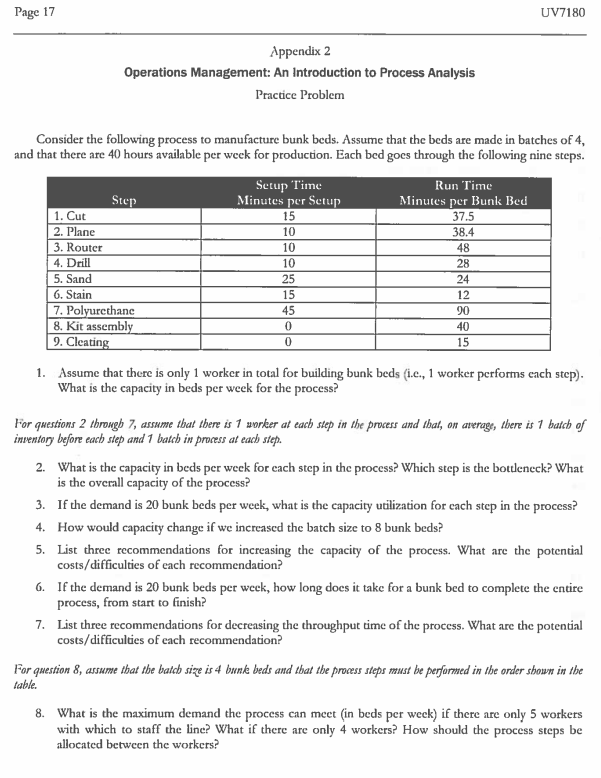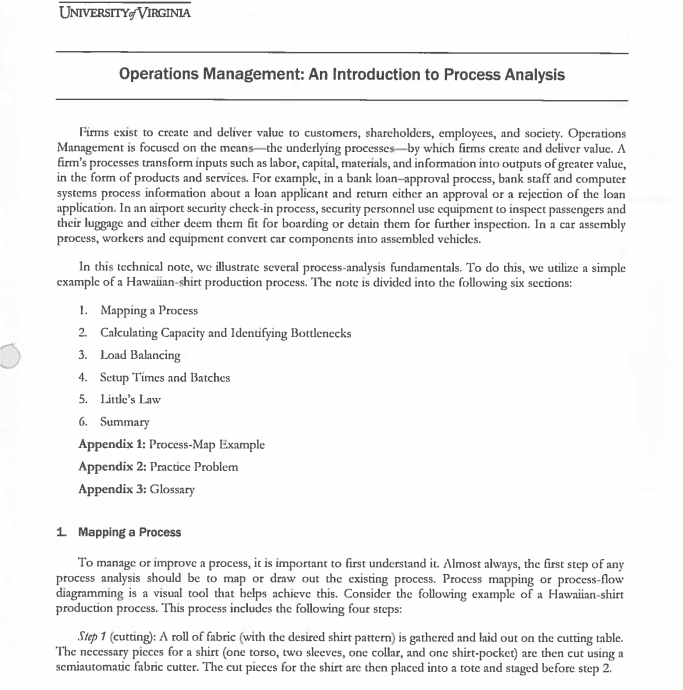Assume that there is only 1 worker in total for building bunk beds (i.c., 1 worker performs each step). What is the capacity in beds per week for the process?
Assume that there is only 1 worker in total for building bunk beds (i.c., 1 worker performs each step). What is the capacity in beds per week for the process?
Practical Management Science
6th Edition
ISBN:9781337406659
Author:WINSTON, Wayne L.
Publisher:WINSTON, Wayne L.
Chapter2: Introduction To Spreadsheet Modeling
Section: Chapter Questions
Problem 20P: Julie James is opening a lemonade stand. She believes the fixed cost per week of running the stand...
Related questions
Question
Please read the case study - Operations Management Case Study - process.pdf " to learn the general areas of importance in process analysis. Understanding process is critical to creation of an efficient flow in designing manufacturing or services.
Please study the Case Study and answer the 8 questions in Appendix 2 on page 17.
Help below-

Transcribed Image Text:Page 17
Appendix 2
Operations Management: An Introduction to Process Analysis
Practice Problem
Consider the following process to manufacture bunk beds. Assume that the beds are made in batches of 4,
and that there are 40 hours available per week for production. Each bed goes through the following nine steps.
Step
1. Cut
2. Plane
3. Router
4. Drill
5. Sand
6. Stain
7. Polyurethane
8. Kit assembly
9. Cleating
Setup Time
Minutes per Setup
15
10
10
10
25
15
45
0
0
Run Time
Minutes per Bunk Bed
37.5
38.4
48
28
UV7180
24
12
90
40
15
1. Assume that there is only 1 worker in total for building bunk beds (i.c., 1 worker performs each step).
What is the capacity in beds per week for the process?
For questions 2 through 7, assume that there is 1 worker at each step in the process and that, on average, there is 1 batch of
inventory before each step and 1 batch in process at each step.
2. What is the capacity in beds per week for each step in the process? Which step is the bottleneck? What
is the overall capacity of the process?
3.
If the demand is 20 bunk beds per week, what is the capacity utilization for each step in the process?
4. How would capacity change if we increased the batch size to 8 bunk beds?
5. List three recommendations for increasing the capacity of the process. What are the potential
costs/difficulties of each recommendation?
6. If the demand is 20 bunk beds per week, how long does it take for a bunk bed to complete the entire
process, from start to finish?
7.
List three recommendations for decreasing the throughput time of the process. What are the potential
costs/difficulties of each recommendation?
For question 8, assume that the batch size is 4 bunk beds and that the process steps must be performed in the order shown in the
table.
8. What is the maximum demand the process can meet (in beds per week) if there are only 5 workers
with which to staff the line? What if there are only 4 workers? How should the process steps be
allocated between the workers?

Transcribed Image Text:UNIVERSITY VIRGINIA
Operations Management: An Introduction to Process Analysis
Firms exist to create and deliver value to customers, shareholders, employees, and society. Operations
Management is focused on the means the underlying processes by which firms create and deliver value. A
firm's processes transform inputs such as labor, capital, materials, and information into outputs of greater value,
in the form of products and services. For example, in a bank loan-approval process, bank staff and computer
systems process information about a loan applicant and return either an approval or a rejection of the loan
application. In an airport security check-in process, security personnel use equipment to inspect passengers and
their luggage and either deem them fit for boarding or detain them for further inspection. In a car assembly
process, workers and equipment convert car components into assembled vehicles.
In this technical note, we illustrate several process-analysis fundamentals. To do this, we utilize a simple
example of a Hawaiian-shirt production process. The note is divided into the following six sections:
1. Mapping a Process
2. Calculating Capacity and Identifying Bottlenecks
3. Load Balancing
4.
5.
6. Summary
Appendix 1: Process-Map Example
Appendix 2: Practice Problem
Appendix 3: Glossary
Setup Times and Batches
Little's Law
1. Mapping a Process
To manage or improve a process, it is important to first understand it. Almost always, the first step of any
process analysis should be to map or draw out the existing process. Process mapping or process-flow
diagramming is a visual tool that helps achieve this. Consider the following example of a Hawaiian-shirt
production process. This process includes the following four steps:
Step 1 (cutting): A roll of fabric (with the desired shirt pattern) is gathered and laid out on the cutting table.
The necessary pieces for a shirt (one torso, two sleeves, one collar, and one shirt-pocket) are then cut using a
semiautomatic fabric cutter. The cut pieces for the shirt are then placed into a tote and staged before step 2.
Expert Solution
This question has been solved!
Explore an expertly crafted, step-by-step solution for a thorough understanding of key concepts.
This is a popular solution!
Trending now
This is a popular solution!
Step by step
Solved in 3 steps

Recommended textbooks for you

Practical Management Science
Operations Management
ISBN:
9781337406659
Author:
WINSTON, Wayne L.
Publisher:
Cengage,

Operations Management
Operations Management
ISBN:
9781259667473
Author:
William J Stevenson
Publisher:
McGraw-Hill Education

Operations and Supply Chain Management (Mcgraw-hi…
Operations Management
ISBN:
9781259666100
Author:
F. Robert Jacobs, Richard B Chase
Publisher:
McGraw-Hill Education

Practical Management Science
Operations Management
ISBN:
9781337406659
Author:
WINSTON, Wayne L.
Publisher:
Cengage,

Operations Management
Operations Management
ISBN:
9781259667473
Author:
William J Stevenson
Publisher:
McGraw-Hill Education

Operations and Supply Chain Management (Mcgraw-hi…
Operations Management
ISBN:
9781259666100
Author:
F. Robert Jacobs, Richard B Chase
Publisher:
McGraw-Hill Education


Purchasing and Supply Chain Management
Operations Management
ISBN:
9781285869681
Author:
Robert M. Monczka, Robert B. Handfield, Larry C. Giunipero, James L. Patterson
Publisher:
Cengage Learning

Production and Operations Analysis, Seventh Editi…
Operations Management
ISBN:
9781478623069
Author:
Steven Nahmias, Tava Lennon Olsen
Publisher:
Waveland Press, Inc.